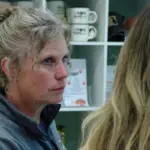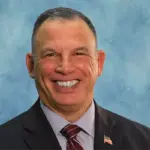Hampstead Teacher Preserves the Memory of 9/11 First Responders
by Linda L. Esterson, photography by Phil Grout
Eighteen years after the tragedy of September 11, 2001, Mike Chrvala wants to make sure that students at Shiloh Middle School remember.
The magnitude of the loss — both of innocent victims and emergency personnel — compelled Chrvala to find a way to detail the importance of the event, which is not included in the county’s middle school history curriculum.
Chrvala, an American history teacher at the Hampstead school, created an after-school program that honors firefighters who perished as they attempted to save citizens trapped in the World Trade Center in New York City on that fateful day. Chrvala’s program, held each spring semester for the past 11 years, matches participating students — who are invited to join after a rigorous application process — with family members of a fallen firefighter. This enables the students to learn about the men and women as people, and not just as names listed among the lost.
“When you think of 2,977 innocent people being murdered, it’s an overwhelming number, as well as impersonal,” he says. “As the kids are assigned one firefighter, they are able to develop a connection to that firefighter and their families, and see the immensity of the loss of one life out of 2,977. It makes it incredibly personal and much more real.”
Participating students watch documentaries and read articles about 9/11. Then they are assigned a firefighter, and provided contact information for a family member. The students speak on the phone or exchange emails with the firefighter’s family, often finding out meaningful details about the firefighter’s life, including photos. They learn about their upbringing, how they dreamed of being a firefighter, and about their spouses, parents, siblings and children. The students use this information to compose a memorial gift for the family. They write poems, create memory boxes, make dioramas and arrange photo collages, which are presented to family members of the fallen as part of a daylong trip to New York. They also visit some of the fallen firefighters’ stations.
This year’s program matched 38 students with spouses, siblings and parents of fallen firefighters, and several students volunteered for a second family. Some families participate every year, while others find it too difficult and don’t return after the first time. Sadly, there are many to go around; 343 New York firefighters were lost that day in New York City, in addition to 23 New York City police officers and 37 Port Authority police officers.
Connecting history on a personal level is the methodology Chrvala employs in his classroom.
“Events like the Battle of Gettysburg and the Declaration of Independence are important due to the actions of the people involved in the events,” said Chrvala, whose email signature includes a quote from the Ancient Greek statesman and general Pericles that applies to his personal philosophy as well as the 9/11 program: “What you leave behind is not what is engraved in stone monuments, but what is woven into the lives of others.”
Chrvala, like many, watched the events of 9/11 unfold on television. The son of a career fireman, he viewed the World Trade Center’s South Tower collapse, and after growing up around his father’s firehouse, knew exactly what was transpiring. He knew hundreds of firefighters were dying alongside the civilian victims.
On each Sept. 11, Chrvala spends a full class period discussing the events of that day in 2001. He realized his class three years ago was the first to comprise students not yet born on 9/11.
“It’s a moment in American history; history is about people,” he said. “Places like Gettysburg and South Manhattan on September 11 are only important because people were there.”
Firefighter Tim Brown, who lost 93 friends that day, visited Shiloh Middle in May to share his experience with the students. Brown, who was outside the South Tower and looked on as the building collapsed, shared his story with the students.
He described how firefighter Mike Lynch was one of the first to the tower and saw Brown outside as he ran to get tools to free people trapped in an elevator. “Timmy, I got it,” was his assurance to his friend. Lynch rescued several women before perishing.
One by one, students named their firefighters, and Brown shared his connection. Some were close friends, while others were acquaintances. He talked about his closest friends, decorated veterans with whom he would meet regularly for meals. All but Brown died, and The New York Times aptly called the group the “Knights of the Roundtable.” He described how he has developed close friendships with family members of his fallen friends, many of whom knew they were going into the tower not to return.
“When they went into the stairwell and went up, they knew they weren’t coming back,” he recalled. “They still did it; that’s the heroes they were.
“All of the men in Rescue 1 were told to evacuate and they ignored it,” he continued. “They knew their brothers were trapped in the building, and they would never leave.”
The students also learn how the tragedy continues with what medical officials dubbed 9/11 Disease. According to the Centers for Disease Control’s World Trade Center Health Program, more than 24,000 9/11 first responders suffer from chronic rhinosinusitis, nearly 22,000 from gastroesophageal reflux disease, more than 12,000 have asthma, nearly 10,000 have been diagnosed with cancer, and more are fighting mental health and sleep issues as a result of their experiences at Ground Zero.
Brown commended Chrvala for developing the project, and for making the tragedy more real for students.
“This guy involving you guys with the families is better than any schoolteacher in America,” he said.
Family members of the fallen firefighters also appreciate Chrvala’s efforts.
“What you are doing for your students is above and beyond and BLESS YOU for that,” wrote Rosemary Cain, mother of fallen firefighter George Cain from Ladder 7, in an email to Chrvala. “They need to know and be prepared but far too often, school systems are dropping the ball…. but this opportunity you give them will last a lifetime…hopefully. Your students, and their families are wonderful with a depth of feeling beyond their years, and it is our pleasure to meet them.”
Erin Eagers, sister of fallen firefighter Tim McSweeney of Ladder 3, wrote a note to Shiloh Middle’s Brielle McNeil, who gave her a shadow box about McSweeney. “I wanted to let you know that I think what Mr. Chrvala is teaching you is more than what happened to our country on 9/11. There are life lessons being learned,” she wrote. “You and your classmates have totally touched a stranger’s life in such a beautiful and positive way. Thank you, Brielle. It’s amazing to know that people still remember and honor all who perished on 9/11. Thank you from the bottom of my heart.”
The last stop on the New York trip was the National Sept. 11 Memorial & Museum at Ground Zero in Manhattan, where each student received a memorial bracelet and a rose, which they placed alongside their firefighter’s name.
The visit evoked a flood of emotion from the students and the chaperones, which included parents and teachers. During the May trip, one of the guards, a retired NYPD officer, told the chaperone teachers that he “hadn’t seen that much emotion from visitors to the memorial in a very long time,” said Chrvala.
Ryehn Byrnes was one of the students particularly emotional at the memorial. “I honestly haven’t cried this hard in a really long time,” she wrote in an Instagram post. “I didn’t cry all day and thought I was heartless or something, then we got to the memorial at dark and I just lost it. There are so many names on that memorial. They didn’t just die of an accident or a disease or something — they were murdered. Remember that. These amazing men and women died because someone didn’t like the way we live.”
Ryehn created a memory box for the sister of Capt. Patrick “Paddy” John Brown, who after serving in the Vietnam War became one of the most decorated firefighters in New York. Brown helped the homeless and taught blind children karate.
“Paddy is so inspirational, and he went into that burning building to save the lives of random strangers, but I’m sure had no second thoughts because that’s what he loved to do,” Ryehn continued in the Instagram post. “Please no one ever forget what happened September 11, 2001. Remember to tell your friends and family you love them because not every day is given to you. I really felt that today.”
Emily Hipsley also posted on Instagram about her assigned firefighter, Jonathan Lee Ielpi, who loved his two children, hockey and camping. She, too, cried her “eyes out” as she left a rose beside Ielpi’s name at the memorial.
“Doing all the research and being able to contact the families of the victims made me feel so much closer to Jonathan Lee Ielpi and made him feel as almost if he was family,” she wrote. “The tragic events and all the victims that were murdered on 9/11 thinking that it would be a normal day and thought that they would all go home to their loved ones will never be forgotten.”
Jordyn Barnes was paired with the family of Battalion Chief Richard A. Prunty, who she called a hero for his role in 9/11 but also for when he slept on his children’s bedroom floors when they were sick, when he served in the military, covered for a co-worker whose wife was delivering a baby, and when he “swore to make any and every sacrifice to save the lives of anyone.”
“Our lives will change when you least expect it,” she wrote on Instagram. “Tell the stories of those you’ve lost, and always tell those you love that you love them. I love you. Never forget.”













